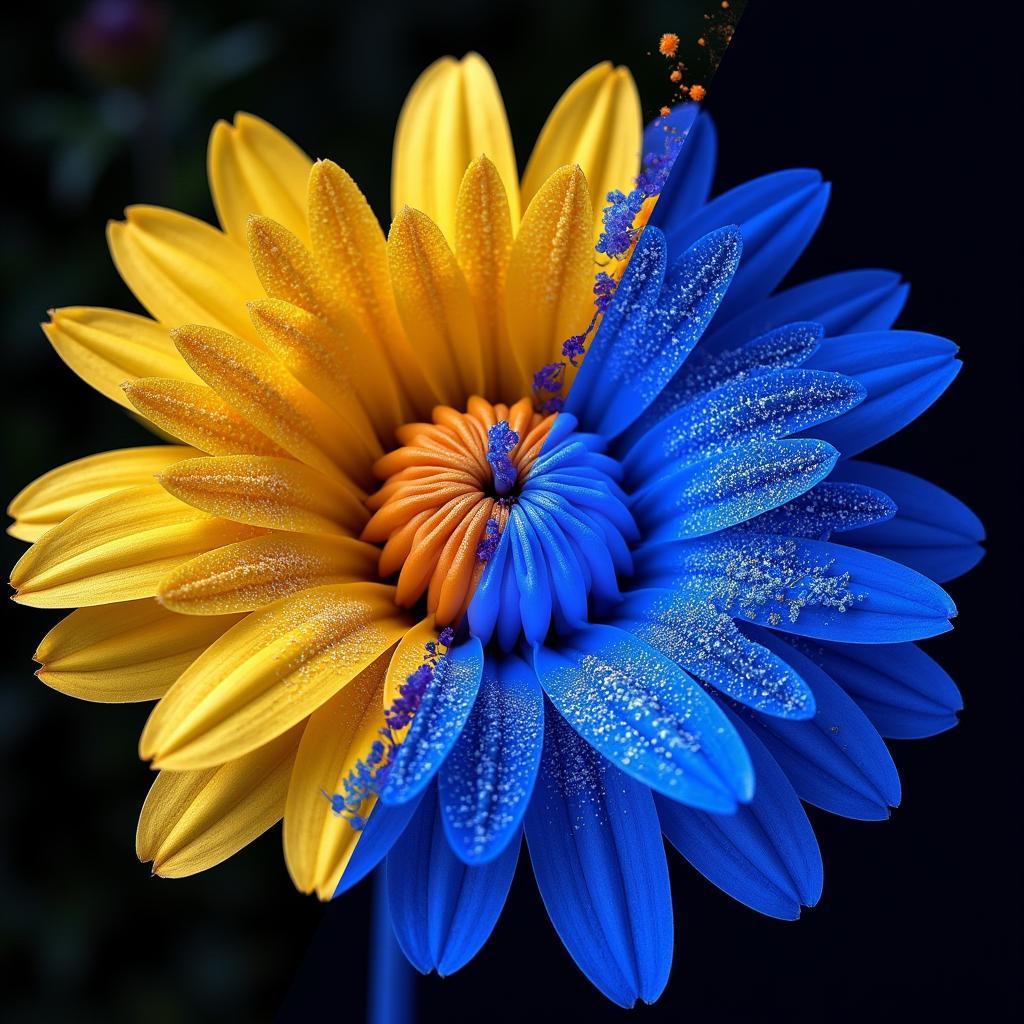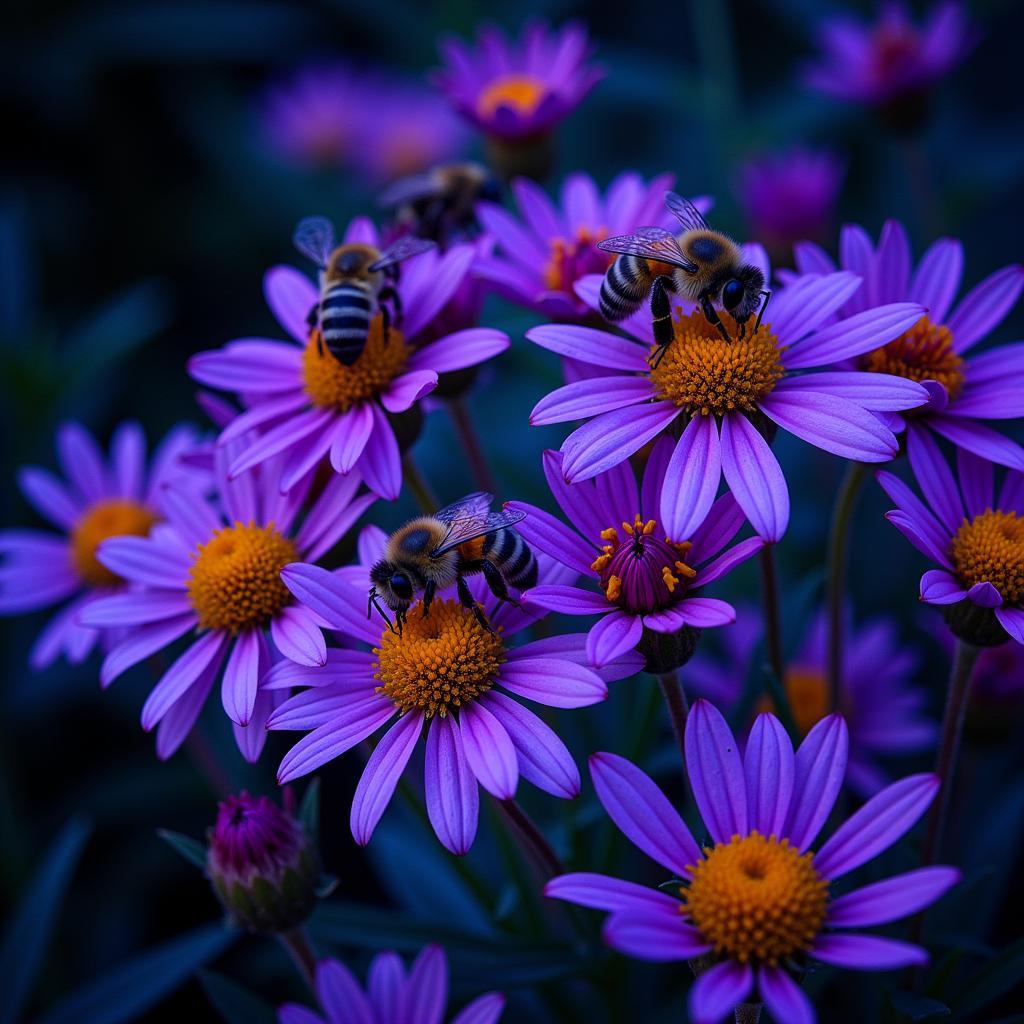Do Bees See Color? This is a fascinating question that delves into the sensory world of these essential pollinators. Understanding how bees perceive color is crucial for comprehending their behavior, their interaction with flowers, and ultimately, their vital role in our ecosystem. Their world of color is far different from our own, influencing their foraging patterns and contributing to the vibrant tapestry of nature.
How Bees See the World: A Different Spectrum
Bees, like humans, have photoreceptors in their eyes that detect light and translate it into images. However, the range of colors they perceive differs significantly from ours. While humans primarily see the colors of the rainbow (red, orange, yellow, green, blue, indigo, and violet), bees can see ultraviolet (UV) light, a wavelength invisible to the human eye. This ability to see UV light opens up a whole new dimension to their visual experience. They don’t see red as we do, perceiving it more as a dark grey or black. Instead, they are particularly attracted to blues, purples, and yellows, often with UV patterns that act like neon signs, guiding them to the nectar and pollen within flowers. What color is clover? It’s a question that takes on a whole new meaning when considering bee vision.
It’s important to understand that bees don’t just see colors differently, they also process visual information much faster than humans. This allows them to navigate rapidly through complex environments and identify flowers while in flight. This speed and precision are crucial to their efficiency as pollinators.
 Bee Vision of Flower UV Patterns
Bee Vision of Flower UV Patterns
Imagine a world where flowers shimmer with hidden patterns, invisible to us but brilliantly clear to bees. This is the reality of bee vision. These UV patterns, often called “nectar guides,” act as landing strips, directing bees to the precise location of the flower’s sweet reward.
The Importance of Color for Pollination
The way bees see color is intrinsically linked to pollination, a process vital for plant reproduction and the food supply we rely on. Flowers have evolved vibrant colors, including those within the UV spectrum, specifically to attract pollinators like bees. The colors act as a beacon, advertising the presence of nectar and pollen, the bee’s primary food sources. As bees move from flower to flower, collecting their food, they inadvertently transfer pollen, facilitating fertilization and ensuring the continuation of plant species. This intricate relationship between color, bee vision, and pollination underscores the essential role these insects play in maintaining biodiversity.
Do Bees See Orange? A Closer Look at Specific Colors
While bees cannot perceive red as a distinct color, their perception of orange is a little more complex. They do see orange, but not as the vibrant hue we experience. It appears more yellowish to them, often blending with the yellows and greens of their visible spectrum. This nuanced understanding of how bees see color helps explain their preference for certain flowers and their foraging patterns. This also relates to the question of can dogs see the color orange, as both species perceive colors differently than humans.
 Bees Pollinating Purple Flowers from a UV Perspective
Bees Pollinating Purple Flowers from a UV Perspective
Expert Insights on Bee Vision and Color
Dr. Melanie Dubois, a leading researcher in bee vision and behavior, explains: “Bees have a remarkably sophisticated visual system. Their ability to see ultraviolet light gives them a unique perspective on the world, particularly when it comes to interacting with flowers. The colors and patterns we see are just a small part of the story. The UV patterns are like a secret language between flowers and bees.”
Professor Eleanor Vance, a specialist in plant-pollinator interactions, adds: “The co-evolution of flower color and bee vision is a testament to the intricate relationships within our ecosystems. Flowers have adapted their color palettes to attract the very creatures that ensure their survival. This beautiful interplay highlights the interconnectedness of nature.”
Conclusion: The Colorful World of Bees
Do bees see color? Absolutely, but in a way that is uniquely their own. Their ability to perceive UV light and their preference for blues, purples, and yellows shapes their interactions with the floral world, driving pollination and ensuring the continuation of plant life. Understanding bee vision provides a deeper appreciation for these remarkable creatures and their crucial role in our ecosystem.
FAQ
- What colors do bees see best? Bees see blues, purples, and yellows most vibrantly. They also see ultraviolet light, which is invisible to humans.
- Do bees see red? No, bees do not see red. It appears as dark grey or black to them.
- Why is color important for bees? Color helps bees locate flowers for nectar and pollen, which are their primary food sources.
- How does bee vision differ from human vision? Bees see ultraviolet light and a different range of colors compared to humans.
- What are nectar guides? Nectar guides are ultraviolet patterns on flowers that help bees locate the nectar and pollen.
- How does bee vision impact pollination? Bee vision is crucial for pollination as it guides them to flowers, allowing them to transfer pollen and facilitate plant reproduction.
- Can I attract bees to my garden with specific colors? Yes, planting flowers in shades of blue, purple, and yellow, particularly those with UV patterns, can attract bees to your garden.
what color are pumpkin flowers
You can find more information about related topics such as “what color are pumpkin flowers”, “what color is a hibiscus”, and others on our website.
Need help choosing the perfect colors for your home to attract these vital pollinators or simply create a vibrant space? Contact us! Phone: 0373298888, Email: [email protected] or visit us at 86 Cầu Giấy, Hanoi. Our 24/7 customer service team is ready to assist you.
